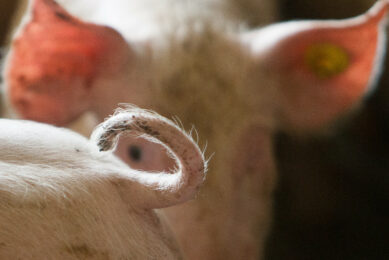Lignocellulose helps to shorten farrowing time

More than 3 minutes – that is the gain in time piglets were observed to have in Austria during a smooth birth process. The 3 minutes of being born quicker means 3 minutes less struggle and getting access to colostrum and oxygen 3 minutes earlier. Now, how to get there?
Recent genetic progress achieved in sows poses a major challenge to management. Many hurdles need to be overcome to make modern pig production as efficient and profitable as possible. Regarding piglet rearing, there is a rule of thumb that seems quite plausible at first glance: more piglets means more profit. Therefore, the breeding goal is to have as many piglets per litter as possible. However, on-farm, increased litter size is often accompanied by low piglet birth weights and increased piglet mortality. Consequently, the pig producer should not aim to have as many newborn piglets as possible, but rather to raise as many robust, viable and competitive weaners as possible.
An underestimated factor of success
Exploiting the full genetic potential and producing large litters of live-born piglets is still possible if enough resources are given to management and if proper, well-balanced sow nutrition is guaranteed.
Large litters are closely related to prolonged farrowing duration. A long parturition time carries the risk of many negative consequences, with the most obvious one being long exposure to pain and a stressful period for both the sows and the piglets. Furthermore, a prolonged farrowing time increases the proportion of stillborn piglets. According to Professor Peter Kappel Theil of Aarhus University, Denmark, extending a birthing period by 100 minutes means the loss of 2 piglets or more. The longer the struggle to pass through the birth canal, the more the piglet is exhausted and disadvantaged compared to highly vital piglets. Those highly active piglets will find the mother’s teats earlier and profit from early feeding which, in turn, beneficially influences gut growth and gut development. Farrowing duration can affect colostrum yield and therefore is directly linked to an optimal supply to the newborn piglets of energy and immunoglobulins (Ig). Just 3 hours after birth, the permeability of the piglet gut for Ig is already reduced to 50%.
Furthermore, a prolonged farrowing time correlates with reduced fertility of sows due to prolonged placenta expulsion.
Management of the farrowing time can influence all of these consequences to a certain extent.
Figure 1 – Duration of farrowing process (in minutes) depending on the feeding regime.

Inclusion of standardised fibre products
Supplementing sow diets with dietary fibre offers the opportunity to reduce the farrowing time via a nutritional tool. The success of dietary fibre inclusion depends mainly on proper selection of the fibre source. In contrast to many conventional fibre sources, such as wheat bran and sugar beet pulp, which vary in quality and availability over the season and bear the risk of mycotoxin contamination, it is advantageous to use standardised, quality proven and sanitised products from wood-derived lignocellulose. In general, fibre is considered in the context of avoiding constipation; however, depending on the quality, lignocellulose has the ability to offer more than that.
Quality of lignocellulose
Current commercially available lignocellulose products can be classified into 2 categories based on their effects in the gastrointestinal tract. As purely insoluble fibre concentrate, lignocellulose products differ highly in their grade of fermentability and thus can affect the animals’ digestive tract via one of the two following effects.

Piglet Special
Minimising piglet mortality is key to successful pig production. Finding the balance between mortality and litter size is one of the major challenges.
Physical effects
Due to its indigestible and non-fermentable fibre content, lignocellulose optimises the consistency of sow faeces, affecting constipation around farrowing. Here, excessively hard faeces create an additional physical barrier (in addition to the already extremely precarious lack of visceral space) and press on the birth canal. Due to its structure-giving properties, lignocellulose provides for an easily deformable consistency of the faeces. It also enhances the peristaltic activity of the gut, further facilitating the passage of the piglets through the birth canal.
Physiological effects
Lignocellulose products that contain insoluble and non-fermentable fibre as well as a portion of insoluble but fermentable fibre give rise to both physical and physiological benefits. The fermentable portion is broken down by microbes in the colon, resulting in the formation of lactic acid and butyric acid. Butyric acid in turn is a valuable source of energy for colonocytes.
Consequently, the animal is better supplied with energy through the absorption of butyric acid than untreated control animals. The sow can receive up to 25% of her maintenance energy requirement from the fermentation of dietary fibre in the colon. The energy from the enzymatic digestion in the small intestine is available up to 5 hours after ingestion, while the fermentation products from the colon are provided over a period of 24 hours. For the sow, this extra energy means reduced hunger and stress and, above all, more energy for the birthing process. This increased energy supply available over a longer time period has a strong influence on the duration of the farrowing length.
Figure 2 – Number of live-born piglets per litter depending on the feeding regime.

Turning theory to practice
In 2019, an Austrian swine producer experienced the difference. Simply by supplementing lignocellulose (OptiCell, Agromed) as an insoluble fibre carrier with fermentable and non-fermentable components to the gestating feed, the entire birth process per sow was shortened by an average of more than 62 minutes compared to the untreated control group. That means that the critical phase of the birth process that every piglet had to go through was three minutes and 21 seconds shorter. Moreover, that reduced parturition length was accompanied by an increase of the number of live-born piglets from an average of 16.7 to 17.6. If the total litter size is included in the comparison, the lignocellulose treatment increased the relative proportion of live-born piglets from 88.8% to 95.1%.
Effective nutritional tool
The farrowing duration of sows is closely related to the proportion of live-born piglets, colostrum yield, piglet performance and the sow’s fertility for the next cycle. A proper selection of the lignocellulose product added to a sow’s gestating diet can help to achieve a faster birth process by optimising gut functions and improving the sow’s energy supply. One of the most effective nutritional tools is the inclusion of a quality, insoluble dietary fibre consisting of both fermentable and non-fermentable components.
References upon request











